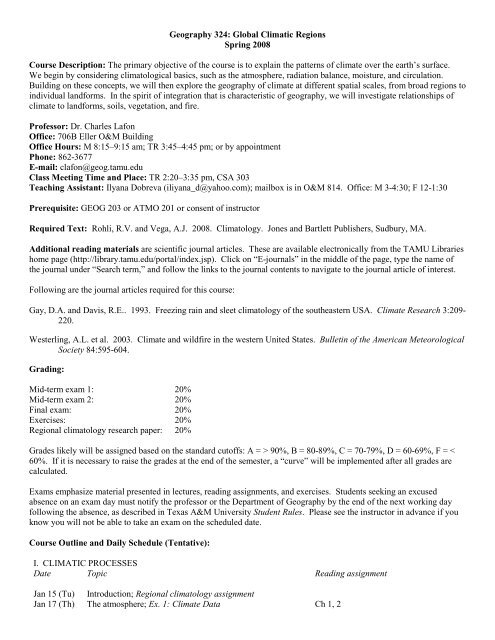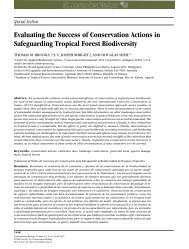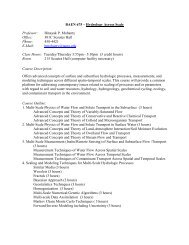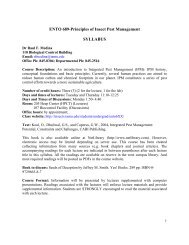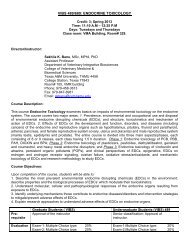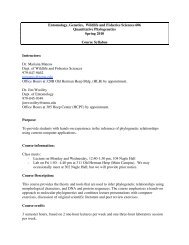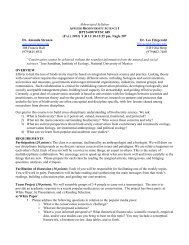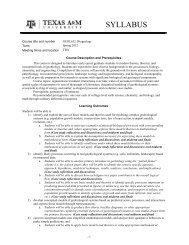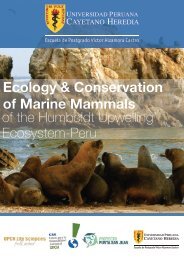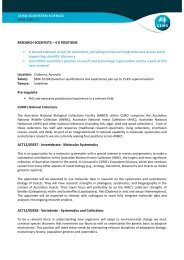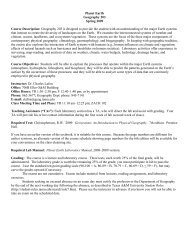Geography 324: Global Climatic Regions - Texas A&M University
Geography 324: Global Climatic Regions - Texas A&M University
Geography 324: Global Climatic Regions - Texas A&M University
You also want an ePaper? Increase the reach of your titles
YUMPU automatically turns print PDFs into web optimized ePapers that Google loves.
<strong>Geography</strong> <strong>324</strong>: <strong>Global</strong> <strong>Climatic</strong> <strong>Regions</strong><br />
Spring 2008<br />
Course Description: The primary objective of the course is to explain the patterns of climate over the earth’s surface.<br />
We begin by considering climatological basics, such as the atmosphere, radiation balance, moisture, and circulation.<br />
Building on these concepts, we will then explore the geography of climate at different spatial scales, from broad regions to<br />
individual landforms. In the spirit of integration that is characteristic of geography, we will investigate relationships of<br />
climate to landforms, soils, vegetation, and fire.<br />
Professor: Dr. Charles Lafon<br />
Office: 706B Eller O&M Building<br />
Office Hours: M 8:15–9:15 am; TR 3:45–4:45 pm; or by appointment<br />
Phone: 862-3677<br />
E-mail: clafon@geog.tamu.edu<br />
Class Meeting Time and Place: TR 2:20–3:35 pm, CSA 303<br />
Teaching Assistant: Ilyana Dobreva (iliyana_d@yahoo.com); mailbox is in O&M 814. Office: M 3-4:30; F 12-1:30<br />
Prerequisite: GEOG 203 or ATMO 201 or consent of instructor<br />
Required Text: Rohli, R.V. and Vega, A.J. 2008. Climatology. Jones and Bartlett Publishers, Sudbury, MA.<br />
Additional reading materials are scientific journal articles. These are available electronically from the TAMU Libraries<br />
home page (http://library.tamu.edu/portal/index.jsp). Click on “E-journals” in the middle of the page, type the name of<br />
the journal under “Search term,” and follow the links to the journal contents to navigate to the journal article of interest.<br />
Following are the journal articles required for this course:<br />
Gay, D.A. and Davis, R.E.. 1993. Freezing rain and sleet climatology of the southeastern USA. Climate Research 3:209-<br />
220.<br />
Westerling, A.L. et al. 2003. Climate and wildfire in the western United States. Bulletin of the American Meteorological<br />
Society 84:595-604.<br />
Grading:<br />
Mid-term exam 1: 20%<br />
Mid-term exam 2: 20%<br />
Final exam: 20%<br />
Exercises: 20%<br />
Regional climatology research paper: 20%<br />
Grades likely will be assigned based on the standard cutoffs: A = > 90%, B = 80-89%, C = 70-79%, D = 60-69%, F = <<br />
60%. If it is necessary to raise the grades at the end of the semester, a “curve” will be implemented after all grades are<br />
calculated.<br />
Exams emphasize material presented in lectures, reading assignments, and exercises. Students seeking an excused<br />
absence on an exam day must notify the professor or the Department of <strong>Geography</strong> by the end of the next working day<br />
following the absence, as described in <strong>Texas</strong> A&M <strong>University</strong> Student Rules. Please see the instructor in advance if you<br />
know you will not be able to take an exam on the scheduled date.<br />
Course Outline and Daily Schedule (Tentative):<br />
I. CLIMATIC PROCESSES<br />
Date Topic<br />
Jan 15 (Tu)<br />
Jan 17 (Th)<br />
Introduction; Regional climatology assignment<br />
The atmosphere; Ex. 1: Climate Data<br />
Reading assignment<br />
Ch 1, 2
Jan 22 (Tu)<br />
Jan 24 (Th)<br />
Jan 29 (Tu)<br />
Jan 31(Th)<br />
Feb 5 (Tu)<br />
Feb 7 (Th)<br />
Feb 12 (Tu)<br />
Feb 14 (Th)<br />
Feb 19 (Tu)<br />
Feb 21 (Th)<br />
Earth’s energy balance<br />
Earth’s energy balance<br />
Temperature patterns<br />
Atmospheric moisture & precipitation; Ex. 1 due<br />
Atmospheric moisture & precipitation; Ex. 2: Seasonality<br />
Isohyets (in-class exercise)<br />
MID-TERM EXAM 1<br />
General circulation; Paper topic (region) due<br />
General circulation; Isohyets exercise due<br />
General circulation<br />
II. GEOGRAPHY OF CLIMATE<br />
Feb 26 (Tu)<br />
Feb 28 (Th)<br />
Mar 4 (Tu)<br />
Mar 6 (Th)<br />
Mar 11 (Tu)<br />
Mar 13 (Th)<br />
Mar 18 (Tu)<br />
Mar 20 (Th)<br />
Mar 25 (Tu)<br />
Mar 27 (Th)<br />
Apr 1 (Tu)<br />
Apr 3 (Th)<br />
Apr 8 (Tu)<br />
Apr 10 (Th)<br />
Apr 15 (Tu)<br />
Apr 17 (Th)<br />
Apr 22 (Tu)<br />
Apr 24 (Th)<br />
Climate classification; Ex. 2 due<br />
Climate classification; Ex. 3: Climate classification<br />
Climate classification<br />
Extratropical Northern Hemisphere climates<br />
Spring Break<br />
Spring Break<br />
Extratropical Northern Hemisphere climates; Ex. 3 due<br />
MID-TERM EXAM 2<br />
Tropical and Southern Hemisphere climates<br />
Tropical and Southern Hemisphere climates<br />
<strong>Climatic</strong> influences on vegetation patterns<br />
Fire climatology<br />
<strong>Climatic</strong> geomorphology<br />
<strong>Climatic</strong> influences on the distribution of soils<br />
AAG<br />
AAG<br />
Student presentations; Regional climatology paper due<br />
Student presentations<br />
Final Exam Date: Wednesday, May 7, 2008, 1:00-3:00 pm<br />
Ch 3, 5<br />
Ch 6<br />
Ch 7<br />
Ch 4<br />
Ch 8<br />
Ch 9; Gay & Davis journal article<br />
Ch 10<br />
Westerling et al. journal article<br />
ADA Statement: The Americans with Disabilities Act (ADA) is a federal anti-discrimination statute that provides<br />
comprehensive civil rights protection for persons with disabilities. Among other things, this legislation requires that all<br />
students with disabilities be guaranteed a learning environment that provides for reasonable accommodation of their<br />
disabilities. If you believe you have a disability requiring an accommodation, please contact the Department of Student<br />
Life, Services for Students with Disabilities in Room B118 of Cain Hall, or call 845-1637.<br />
Copyright and Plagiarism policy: The materials used in this course are copyrighted. These materials include but are not<br />
limited to syllabi, quizzes, exams, lab problems, in-class materials, review sheets, and additional problem sets. Because<br />
these materials are copyrighted, you do not have the right to copy the handouts, unless permission is expressly granted.<br />
As commonly defined, plagiarism consists of passing off as one’s own the ideas, words, writings, etc., which belong to<br />
another. In accordance with this definition, you are committing plagiarism if you copy the work of another person and<br />
turn it in as your own, even is you should have the permission of that person. Plagiarism is one of the worst academic<br />
sins, for the plagiarist destroys the trust among colleagues without which research cannot be safely communicated.<br />
If you have any questions regarding plagiarism, please consult the latest issue of the <strong>Texas</strong> A&M <strong>University</strong> Student Rules,<br />
http://student-rules.tamu.edu, under the section “Scholastic Dishonesty.”<br />
Aggie Honor System Office website: http://www.tamu.edu/aggiehonor/


